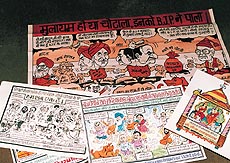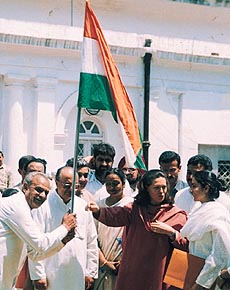

 
 


 
 
|
He infuses colour into campaigns
By Ajay Jha
THE summer of 1961. A limousine,
so rare those days in New Delhi that it was virtually a
statement of the owner’s status, drew to a halt. The
chauffeur, emerging out of the car, walked straight to a
group of motor cycle-rickshaw drivers awaiting
passengers. He whispered a name in a low voice and
suddenly all eyes turned towards a young man. Parshotam
Kumar, barely 25, had just about joined their ranks. Fear
was writ large on their faces as he was ordered to board
the car. Despite the poor literacy rate of the then
India, his colleagues were literate enough to read
"Home Ministry" inscribed above the
registration plate.
 The same driver who had virtually forced
him to board the car was taken aback. His sahib, a
senior Home Ministry official, was begging for
forgiveness with folded hands, without bothering that his
subordinates were watching him do so. The same driver who had virtually forced
him to board the car was taken aback. His sahib, a
senior Home Ministry official, was begging for
forgiveness with folded hands, without bothering that his
subordinates were watching him do so.
A similar scene was
enacted outside the court premises within days. The same
police officers who had treated him like dirt the other
day were now sweet like honey to him. They did not want
him to pursue his case any further. He accepted a hefty
some of money offered as compensation, rather the price
for an out-of-the-court settlement. That was a big price
the mighty lot had to pay at a time when citizens
generally feared sahibs and the men in uniform
— a legacy of the colonial rule. A powerful
bureaucrat slapping a young driver who had accidentally
knocked down the former’s servant and the
highhandedness of a zealous police officer all out to
please his boss may not have been unusual. The unusual,
however, was the way Parshotam Kumar had reacted to this.
As the saying goes, the morning shows the day. Parshotam
Kumar was destined to be a man who would take the high
and mighty head-on in the years to come.
Limousines still come
for him, but chauffeurs do not have to ask for him
anymore. He is much sought after by the high and the
mighty, particularly with elections just round the
corner. Telephones seldom stop ringing at his small
office located inside a yet-to-be-finished building in
Karol Bagh, Delhi. Times have changed. Today he can
afford to be choosy, prefer not to take calls and decide
for himself whom he wants to oblige. Famous as Parshotam
Vinayak now, he obliges favour-seekers. The
favour-seekers incidentally are no lesser mortals,they
are some of the big names of the Indian politics. He
holds no post, but many think he can still make a
difference between defeat and a close victory at the
hustings. Vinayak’s unique style and innovative
ideas have made him a master of political publicity.
 It all
started in 1959 when he was forced to resign from the EME
unit of the Indian Army where he was working as a fitter.
He raised his voice against exploitation of civilians
working in the military services. He made an effigy of
the Commanding Officer, a colonel, and burnt it inside
Delhi cantonment. The result: he was asked either to
resign or be ready to be shot dead. He opted for the
former and started driving motor cycle-rickshaw to earn a
living. He, however, had taken the lead, as he
inadvertently became one of the founders of the powerful
All India Defence Employees Federation, the union of
civilians working with the Army. This was just the
beginning of a long innings ahead. Only if he had
bothered to keep a proper record, he would have been
qualified to get an entry into the Guinness Book of
World Records for holding the maximum number of
demonstrations, plastering Delhi’s walls with
humorous posters and burning effigies. For the last 40
years he has been doing it with religious regularity,
nothing less than one a month on an average. "I
cannot remember the number, but all I can say is that
there has been no corrupt politician, no matter which
party he belonged to, whose effigy I have not burnt
during the last four decades," says Vinayak, who
runs an organisation by the name of All India
Bhrashtachar Virodhi Morcha (All India Anti-Corruption
Front). It all
started in 1959 when he was forced to resign from the EME
unit of the Indian Army where he was working as a fitter.
He raised his voice against exploitation of civilians
working in the military services. He made an effigy of
the Commanding Officer, a colonel, and burnt it inside
Delhi cantonment. The result: he was asked either to
resign or be ready to be shot dead. He opted for the
former and started driving motor cycle-rickshaw to earn a
living. He, however, had taken the lead, as he
inadvertently became one of the founders of the powerful
All India Defence Employees Federation, the union of
civilians working with the Army. This was just the
beginning of a long innings ahead. Only if he had
bothered to keep a proper record, he would have been
qualified to get an entry into the Guinness Book of
World Records for holding the maximum number of
demonstrations, plastering Delhi’s walls with
humorous posters and burning effigies. For the last 40
years he has been doing it with religious regularity,
nothing less than one a month on an average. "I
cannot remember the number, but all I can say is that
there has been no corrupt politician, no matter which
party he belonged to, whose effigy I have not burnt
during the last four decades," says Vinayak, who
runs an organisation by the name of All India
Bhrashtachar Virodhi Morcha (All India Anti-Corruption
Front).
It was a quirk of fate
that Vinayak, who was a member of the Rightist Jana Sangh
for close to 25 years, drifted closer to Indira Gandhi.
He was among the bitter critics of Indira Gandhi and was
even arrested for a while during the infamous Emergency.
However, within a few months of the Opposition coming to
power in 1977, he had a change of heart. "All my
life I fought corruption but realised leaders of the
Janata Party were more corrupt than the Congress,"
recalls Vinayak. When Indira Gandhi was down in the
dumps, and even her loyalists had deserted her, Vinayak
joined hands with her. Gandhis never forgot that and ever
since he has come to be recognised as a Gandhi family
loyalist for whom doors of 10, Janpath, are always open.
Probably because he does not seek favours.
It is intriguing to
imagine that someone who has been so sought after and has
been lurking around the power centre has never been
offered any post in any of the parties. "Simple. I
go beyond party affiliations when it comes to corruption.
I have spared none thus far. I never asked for a post,
none offered me, neither the Jana Sangh nor the
Congress," he says and adds, " I have my own
organisation. They cannot dislodge me from this post at
least." His sense of humour is evident in his
posters, cassettes and publicity material.
While he claims to spare
none, he has been particularly harsh on his former
colleagues who are now in the Bharatiya Janata Party. But
that does not mean he is soft towards the Congressmen.
His most memorable moments are when he burnt effigies of
former President Giani Zail Singh after it was disclosed
that he had once almost dismissed the Rajiv Gandhi
government in collusion with the opposition parties and
then there was a series of demonstrations against the
then Prime Minister P.V. Narasimha Rao. "It was fun
fighting against my own partymen, because they were wrong
and corrupt," he says with his trademark smile.
Innovation in publicity
is his hallmark. Long ago he realised that wall posters
were getting too common and boring. So instead of having
normal posters, he went in for cartoons and caricatures
where his characters said it all. "They are
eye-catching and people do stop to read the whole
content." Similarly, much before satellite channels
realised the potential of Hindi film songs, Vinayak had
started making political parodies based on the tunes of
popular songs. He writes the lyrics and has a team of
musicians who perform live when he takes out his
vehicle-mounted demonstrations. During elections he
invariably comes out with two-three such cassettes that
he supplies to Congress candidates free of cost all over
the country.
Vinayak has one ability
— he is not afraid of calling a spade a spade.
Despite being on the forefront of ‘bring Sonia into
politics’ campaign after the assassination of Rajiv
Gandhi and among the most vociferous to demand reversal
of her decision after she resigned as the Congress leader
recently, he loses no time in saying: "Sonia Gandhi
should follow Mahatma Gandhi. She should confine herself
to the task of leading the party and not seek
power."
Vinayak’s utility
or his nuisance value, depending upon which political
party one belongs to, is rather too well known. If he is
capable of damaging someone’s electoral prospects,
as he did during last year’s Delhi assembly
elections by concentrating on the rising prices of onion,
he is also capable of creating goodwill for a candidate.
Some persons have even tried to ape him. "You can
copy my style, but how can you copy my inspiration?"
he says. True, his inspiring ideas infuse enthusiasm
whenever the Congress finds itself down in the dumps.
So is he ready for the
elections? "Not yet. Politics can wait for a while.
It is time to think of the nation," Vinayak says,
referring to the Pakistan-led infiltration in Kashmir.
For record, Vinayak does not drive motor cycle-rickshaws
anymore. He dabbles in politics, deals in properties and
drives around in his own limousine.
|

![]()

